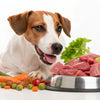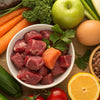Why Raw Dog Food Is Best: Understanding the Benefits of Nature's Diet for Your Dog
- Houndsy
Table of Contents
- Introduction
- The Evolution of Dog Diets: Ancestral Roots
- The Importance of Quality Ingredients
- Transitioning to a Raw Dog Food Diet
- The Role of Houndsy in Elevating the Feeding Experience
- Reflecting on Your Dog’s Diet: A Call to Action
Introduction
Have you ever noticed how your dog seems to thrive on the occasional bite of raw meat from your dinner plate? According to a recent survey, nearly 60% of dog owners report that their pets enjoy fresh, raw ingredients more than conventional kibble. With an increase in interest towards raw dog food diets, we’re inspired to delve deeper into why these diets are perceived as beneficial, how they relate to our dogs' natural dietary needs, and the factors involved in making a safe transition. In this blog post, we will explore why raw dog food is best, empowering you as a pet parent with the knowledge to enhance your dog's well-being.
By the end, you will understand the fundamental principles of a raw dog food diet, identify its advantages and downsides, and discover how to responsibly integrate this into your dog's feeding routine. Join us as we revisit our dogs' ancestral diets, clarify common misconceptions, and uncover the reasons why so many pet parents are making the switch. Let’s embark on this journey together and reflect on our feeding practices while considering if raw dog food could elevate our beloved companions’ lives.
The Evolution of Dog Diets: Ancestral Roots
Our canine companions are descended from wolves, which primarily thrived on a raw diet consisting of fresh meat, bones, and the occasional plant matter. The premise of a raw dog food diet is built on the idea that feeding dogs as their ancestors ate—raw, nutrient-rich components—aligns with their biological and physical needs. This concept has been championed by enthusiasts advocating the premise of the BARF (Biologically Appropriate Raw Food) diet.
The Composition of Raw Diets
Raw dog food diets typically include:
- Muscle meat – Often served with bones still attached.
- Organ meats – Such as livers and kidneys that provide essential nutrients.
- Whole or ground bones – Offering calcium and phosphorus.
- Raw eggs – A protein-rich addition.
- Fruits and vegetables – Providing vitamins and minerals.
- Dairy products – Such as yogurt for digestive health.
These ingredients are intended to replicate the natural diet that dogs would have consumed in the wild, emphasizing a healthy balance of protein, fats, and carbohydrates.
The Case for Raw: Nutritional Benefits
Feeding your dog raw food can yield many benefits that resonate with pet owners committed to giving their animals the best. Here are some noteworthy advantages:
-
Improved Digestive Health: Raw diets often lead to better digestion, as they contain enzymes and nutrients inherent in their unprocessed state. Studies show that raw diets may even result in smaller, firmer stools due to better nutrient absorption.
-
Healthier Skin and Coat: A diet rich in omega fatty acids found in raw meats enhances skin health and can lead to clearer, shinier coats. Many dog owners have reported noticeable improvements in skin condition shortly after switching to a raw diet.
-
Increased Energy Levels: Dogs on raw diets often exhibit higher energy and vitality. Their ancient digestive system processes raw food more effectively, providing energy levels more suited to their activity needs.
-
Reduced Risk of Allergies and Food Sensitivities: By feeding a diet composed of whole ingredients without fillers and artificial additives, many owners find that their pets experience fewer food sensitivities and allergic reactions.
-
Better Dental Health: The natural chewing action required by raw meaty bones can help reduce plaque buildup, promoting better oral hygiene.
Understanding the Risks
While there are compelling arguments for raw dog food diets, it is critical to approach them with care. Opponents often raise concerns regarding:
-
Bacterial Contamination: Raw meat has the potential to harbor harmful bacteria such as Salmonella and E. coli. It's essential to handle raw food safely and keep the feeding area sanitized.
-
Nutritional Imbalances: Formulating a balanced raw diet requires knowledge of canine nutrition. Poorly prepared meals can lead to deficiencies or excesses in vital nutrients that could harm your dog over time.
-
Financial Implications: High-quality raw dog food can be more expensive than conventional kibble, particularly if you opt for premium ingredients.
-
Handling and Preparation: Raw diets necessitate careful handling processes, which may be off-putting for some owners. Ensuring hygiene and safety is paramount when transitioning to raw feeding.
The Importance of Quality Ingredients
When considering a raw dog food diet, sourcing high-quality ingredients is crucial. The integrity of a diet significantly influences its effectiveness and safety. Here are some factors to look for:
-
Ethically Sourced Proteins: Consider meats that are human-grade and sourced from reputable suppliers to minimize the risk of contamination.
-
Variety of Proteins: Including different meats such as chicken, beef, or lamb can offer a versatile array of nutrients.
-
Additives and Preservatives: Choose raw diets that are free from chemicals, fillers, and artificial preservatives to ensure your dog receives clean nutrition.
-
Consultation with Experts: Collaborate with a veterinary nutritionist to ensure the diet meets the nutritional profiles set by the Association of American Feed Control Officials (AAFCO).
Transitioning to a Raw Dog Food Diet
Switching your dog to a raw diet can be an exciting journey, but it's important to take a strategic approach to ensure a smooth transition. Here are some actionable steps:
-
Gradual Introduction: To mitigate digestive upset, introduce raw food gradually over 7 to 10 days. Start by mixing a small amount of raw food with your dog's regular diet, gradually increasing the raw portions.
-
Monitor Your Dog: Keep an eye on your dog’s reaction to the new diet. This includes paying attention to bowel movements, energy levels, and overall behavior.
-
Seek Guidance: Collaborate with veterinarians or pet nutritionists familiar with raw feeding to provide tailored advice for your dog's specific needs.
-
Keep It Safe: Adhere to safe food handling practices to protect both your dog and your family from potential bacteria involved in raw feeding.
-
Experiment with Variety: Raw diets can include a range of meats and meals. Experimenting with different proteins can help avoid monotony and encourage palate diversity.
The Role of Houndsy in Elevating the Feeding Experience
At Houndsy, we are passionate about enhancing your pet care experiences. Our flagship product, the Houndsy Kibble Dispenser, is designed to simplify feeding, ensuring every meal is served in perfect portions without the mess.
As we advocate for better feeding experiences, we recognize that transitioning to a raw diet can be paired wonderfully with our products—making feeding cleaner, easier, and more enjoyable for you and your furry companions.
By combining convenience with thoughtful design, we help you create an environment that elevates your daily pet care routine.
Reflecting on Your Dog’s Diet: A Call to Action
As we reflect on how we feed our beloved pets, we invite you to consider your feeding approach. Is it time to explore the benefits of a raw dog food diet? If you haven’t already, think about how switching to a fresh, natural feeding method could enhance the health and happiness of your dog.
Engage with us at Houndsy, and let’s discuss ways to elevate your dog feeding experience. You can explore more about the Houndsy Kibble Dispenser here.
FAQ
Is a raw dog food diet safe for all dogs?
Not all dogs may do well on a raw diet. It is essential to consult your veterinarian, especially if your dog has health concerns, is a puppy, or is immunocompromised.
How can I ensure that my dog receives a balanced raw diet?
To provide a balanced diet, include various protein sources such as muscle meat, organ meat, and bones. Consulting with a veterinary nutritionist ensures you meet essential nutritional requirements.
What is the best way to transition my dog to a raw diet?
Begin the transition gradually by introducing small amounts of raw food mixed with their current diet over a period of 7 to 10 days. Monitor your dog’s digestion and energy levels during this period.
Are there benefits to raw feeding that are scientifically backed?
While anecdotal evidence supports many benefits, more scientific research is needed to validate these claims. However, some nutritional advantages such as improved digestibility and energy levels are reported by numerous dog owners.
Can I use the Houndsy Kibble Dispenser for raw food?
While the Houndsy Kibble Dispenser is primarily designed for dry food, it can be an integral part of your pet feeding setup when transitioning between feeding styles. Always ensure raw food is stored and handled correctly.
By learning about the benefits and challenges of feeding raw, we can make informed choices that help our dogs thrive. Let’s commit to exploring new feeding options together!












